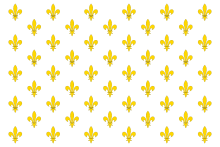- Dukes in France
-
The title of Duke was the highest title in the French nobility during the time of the monarchy in France.
Contents
Old dukedoms
The highest precedence in the realm, attached to a feudal territory, was given to the twelve original pairies, which had originated in the Middle Ages and also had a traditional function in the royal coronation, comparable to the German imperial archoffices.
Half of them were Dukes and half of them Counts. Of these, three were ecclesiastical and three were secular. Of these twelve, the prelates all ranked above the secular peers of the realm and three temporal, and the dukes all ranked above the counts.
Ecclesiastical Dukes
The Prince-Bishops with ducal territories included:
- The Archbishop of Reims, styled archevêque-duc pair de France (in Champagne; who crown and anoint the king, traditionally in his cathedral)
- Two suffragan bishops, styled evêque-duc pair de France :
Later, the Archbishop of Paris was given the title of duc de Saint-Cloud with the dignity of peerage, but it was debated if he was an ecclesiastical peer or merely a bishop holding a lay peerage.
Secular dukes
The secular dukes in the peerage of the realm were, again in order of precedence:
- Duke of Burgundy (known as Grand duc; not a separate title at that time, but a description of the wealth and power of the 15th century Dukes, cousins of the Kings of France) : bears the crown, fastens the belt
- Duke of Normandy : holds the first square banner
- Duke of Aquitaine (also called duc de Guyenne) : holds the second square banner
It should be noted what the theory of the participation of the peers in the coronation was laid down in the late 13th century, when some of the French peerages (the Duchy of Normandy and the County of Toulouse) had already been merged in the crown.
Early Modern period
At the end of the 13th century, the King elevated some counties into duchies, a practice that increased through the early modern period until the French Revolution. Many of this duchies were also peerages, so-called new peerages.
Other duchies of note include:
- Duke of Angoulême
- Duke of Anjou
- Duke of Auvergne
- Duke of Bourbon
- Duke of Brittany (considered a particular state until personal union with France, by the marriage of Anne of Brittany with the French kings Charles VIII and Louis XII and of her daughter Claude with Renaissance King Francis I, who conclude the 1553 treaty rendering the union permanent while granting some autonomy)
- Duke of Broglie
- Duke of Guise
- Duke of Lorraine
- Duke of Montpensier
- Duke of Savoy (although Haute Savoie is now part of France, the Dukes of Savoy were Princes of the Holy Roman Empire, not peers of France)
The title of Duke of France refers to the rulers of the Île de France, informally Francia. The dynasts of Robert the Strong's family are usually termed "Dukes of France" and their title evolved into the name for the French nation after one of their members, Hugh Capet, ascended the throne. Since the end of the monarchy, it has been used by pretenders to the French throne such as Prince Henri, Count of Paris.
New dukedoms
After the French Revolution, further dukedoms were created by successive French rulers. Napoleon Bonaparte created a substantial number of dukes in the Nobility of the First French Empire, largely for Marshals of the Empire and certain ministers, and many of them carried victory titles. The practice of creating dukedoms was continued by the House of Bourbon after the Restoration.
See also
Wikimedia Foundation. 2010.

